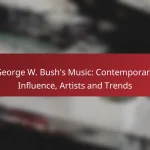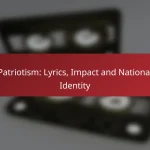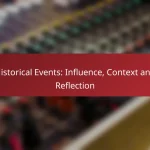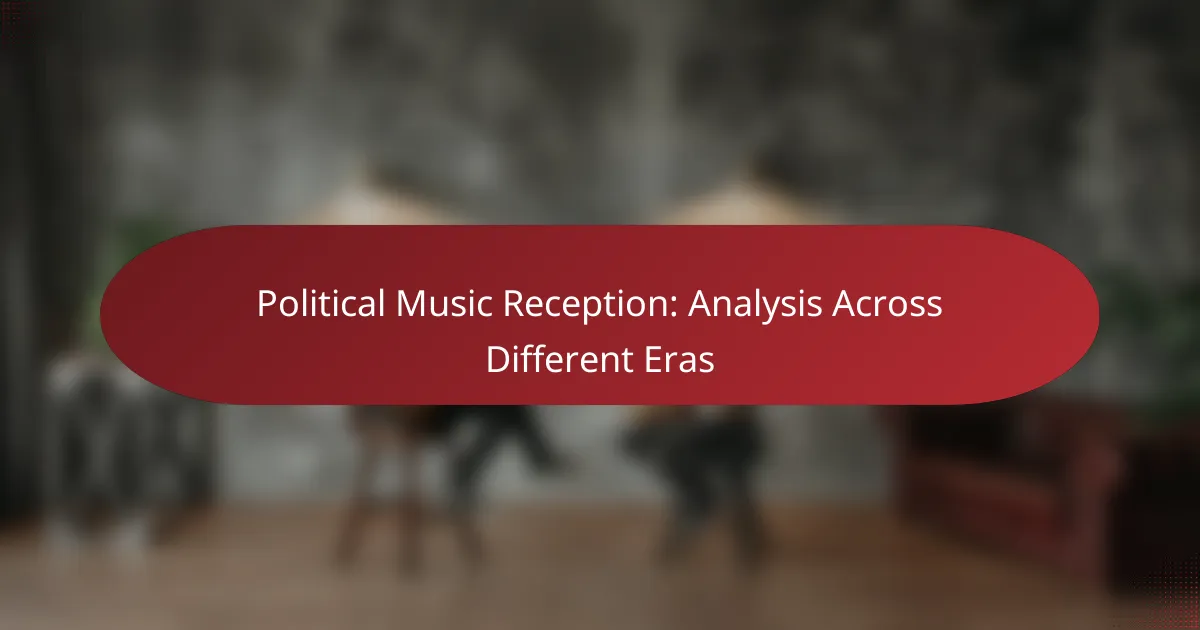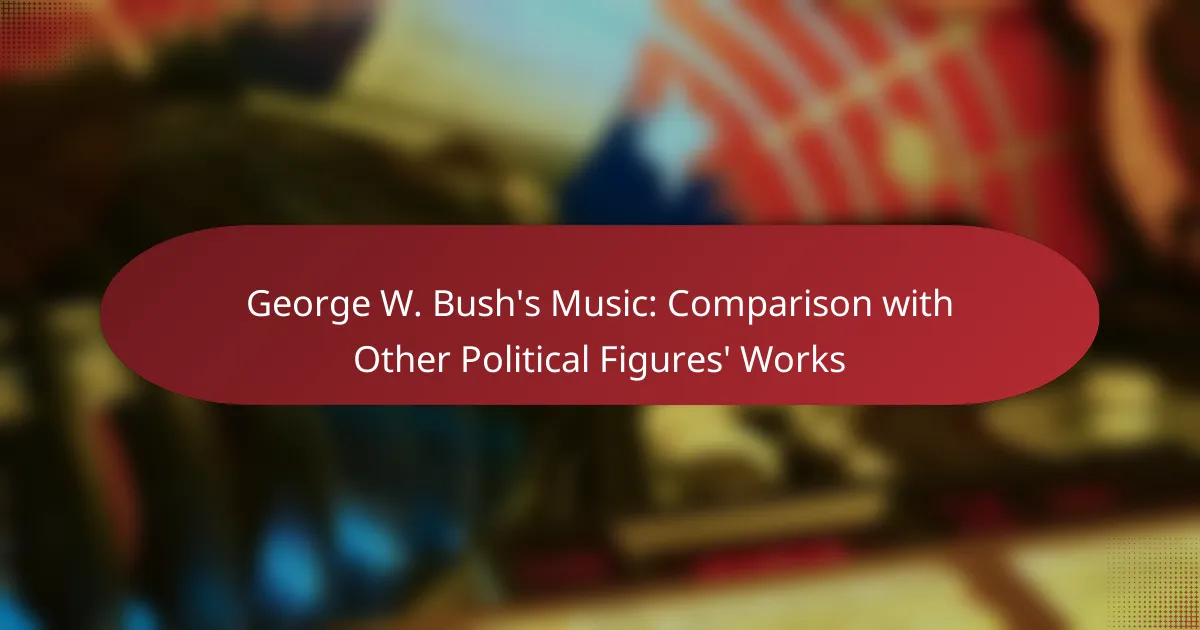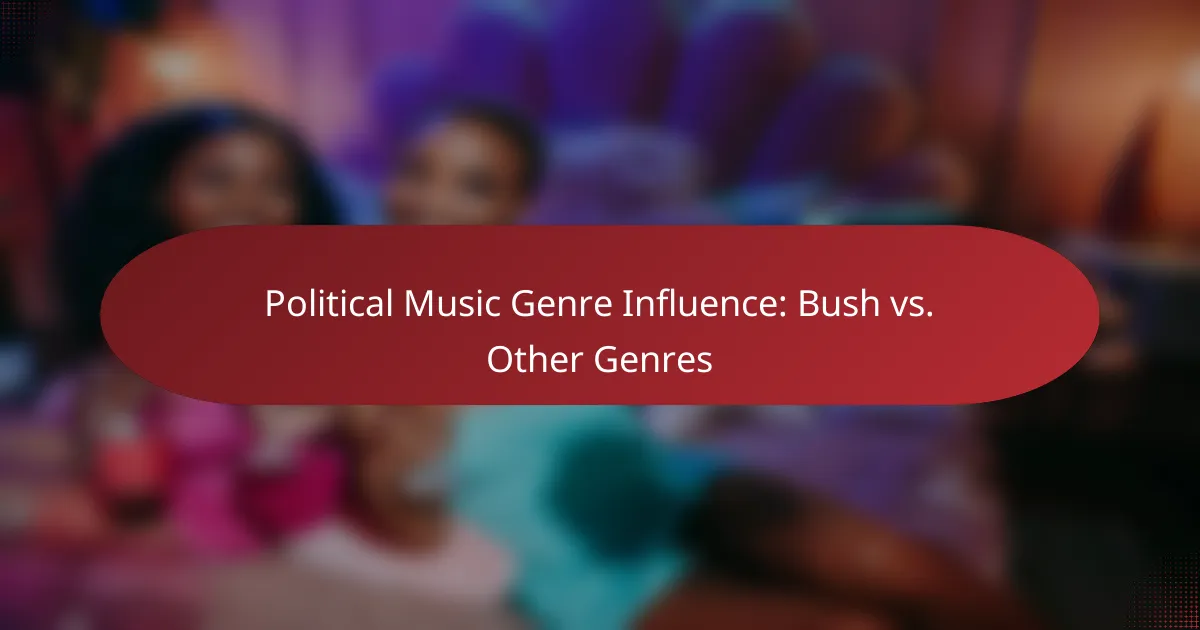The political music landscape underwent a notable evolution during the presidencies of George W. Bush and Barack Obama, marked by distinct genres and messages. Bush’s era was characterized by a rise in protest songs, often rooted in rock and country, reflecting dissent against his administration’s policies. In contrast, Obama’s presidency saw the integration of contemporary pop culture and social media, leading to a surge in hip-hop and pop music that resonated with a broader audience and addressed pressing social issues.

How did political music evolve during George W. Bush’s presidency?
During George W. Bush’s presidency, political music experienced a significant transformation, characterized by a surge in protest songs and the emergence of new genres that addressed social and political issues. This period saw artists using their platforms to voice dissent against government policies, particularly regarding the Iraq War and domestic policies.
Rise of protest music
The rise of protest music during Bush’s presidency was marked by a renewed focus on social justice and anti-war sentiments. Artists began to create music that directly challenged government actions, particularly the invasion of Iraq in 2003. This genre became a powerful tool for mobilizing public opinion and fostering community activism.
Many musicians drew inspiration from historical protest movements, echoing the styles and themes of the 1960s and 1970s. The combination of personal narratives and broader political critiques resonated with audiences, leading to increased engagement in political discourse.
Influence of hip-hop and rock genres
Hip-hop and rock genres played a crucial role in shaping the political music landscape during this time. Hip-hop artists, in particular, used their lyrics to address issues like racial inequality, economic disparity, and the consequences of war. This genre’s raw and direct style appealed to younger audiences, making it a vital part of the political conversation.
Rock music also saw a resurgence of politically charged themes, with many bands incorporating social commentary into their work. The fusion of these genres allowed for a diverse range of expressions, making political music more accessible and relatable to a wider audience.
Key artists and songs
Several key artists emerged as prominent voices in political music during Bush’s presidency. Notable figures included Green Day, whose album “American Idiot” became an anthem for disillusioned youth, and Eminem, who used his platform to criticize the administration’s policies through songs like “Mosh.”
Other significant contributions came from artists like Bruce Springsteen and Rage Against the Machine, who continued to challenge the status quo with their music. These artists not only highlighted pressing issues but also inspired listeners to engage in activism and political awareness.
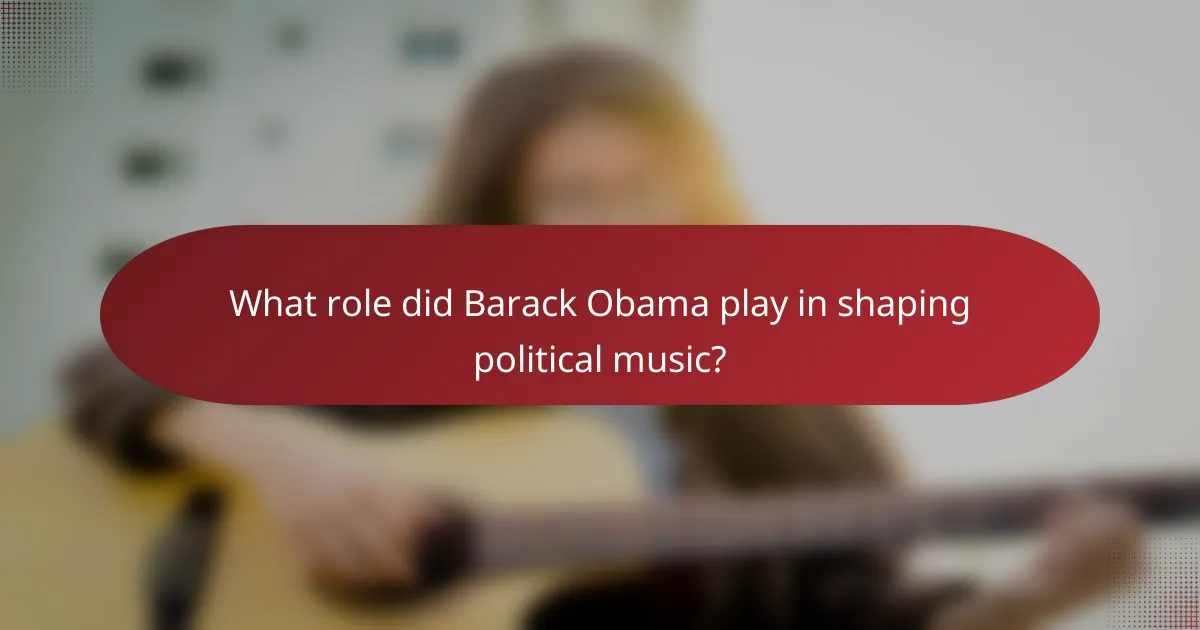
What role did Barack Obama play in shaping political music?
Barack Obama significantly influenced political music by integrating contemporary pop culture and leveraging social media for music distribution. His presidency saw a rise in politically charged songs that resonated with a diverse audience, reflecting the changing landscape of American politics.
Integration of pop culture
Barack Obama’s approach to political music involved a seamless blend of pop culture elements, making political messages more relatable and engaging. Artists like Jay-Z and Beyoncé openly supported him, using their platforms to reach millions and amplify political themes.
This integration helped to humanize political discourse, allowing voters to connect emotionally with issues through familiar musical styles. Songs that addressed social justice, healthcare, and equality became anthems, energizing younger voters and fostering a sense of community.
Impact of social media on music distribution
Social media transformed how political music reached audiences during Obama’s presidency. Platforms like Twitter, Facebook, and YouTube enabled artists to share their work instantly, bypassing traditional media channels and allowing for rapid dissemination of politically charged songs.
This shift meant that music could respond quickly to current events, making it a powerful tool for activism. Viral campaigns often emerged around specific songs, mobilizing support and raising awareness on critical issues in real-time.
Notable collaborations and performances
Obama’s era featured numerous notable collaborations that highlighted the intersection of politics and music. Events like the “We Are One” concert showcased performances by various artists, uniting them under a common cause and promoting civic engagement.
Collaborations with musicians such as Common and Jennifer Hudson not only brought attention to social issues but also emphasized the importance of artistic expression in political movements. These performances often served as rallying points, inspiring audiences to participate in the democratic process.
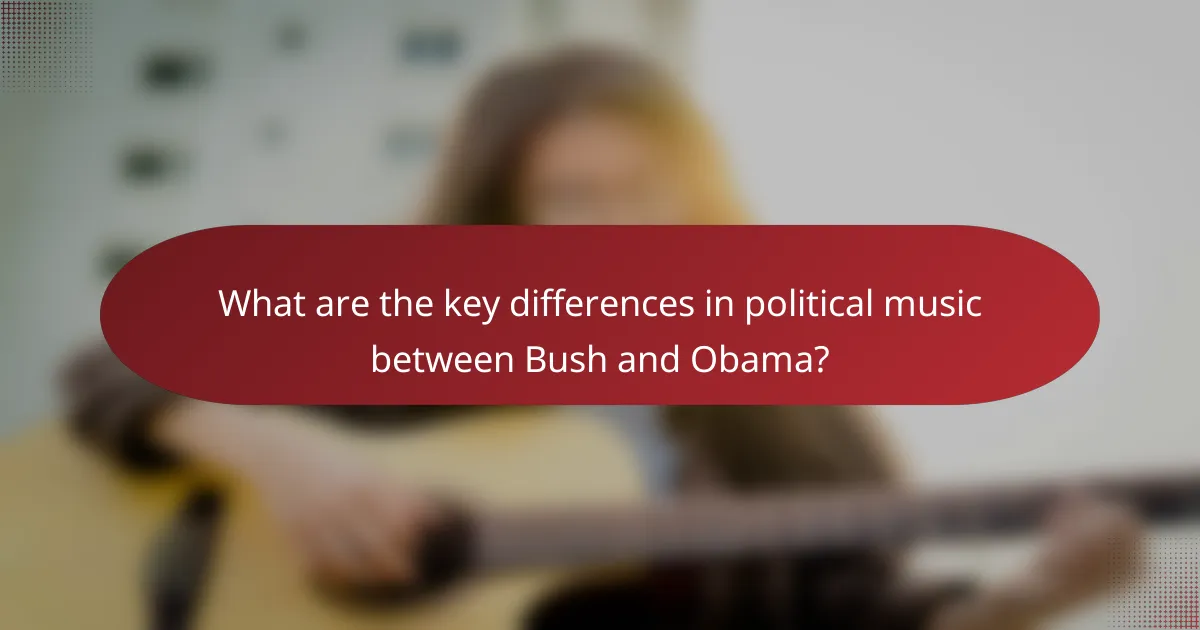
What are the key differences in political music between Bush and Obama?
The political music associated with George W. Bush and Barack Obama reflects distinct differences in genres, messages, and engagement strategies. Bush’s era often featured rock and country influences, while Obama’s time saw a rise in hip-hop and pop, each conveying unique political narratives and connecting with audiences in different ways.
Genres and styles
During George W. Bush’s presidency, political music predominantly leaned towards rock and country genres, with artists like Toby Keith and Bruce Springsteen using their platforms to express support or dissent. This style resonated with traditional American values and often appealed to a more conservative audience.
In contrast, Barack Obama’s administration embraced a broader range of genres, particularly hip-hop and pop. Artists such as Jay-Z and Beyoncé played significant roles in his campaigns, using contemporary sounds to engage younger voters and promote messages of hope and change.
Message and tone
The music associated with Bush often conveyed themes of patriotism and resilience, reflecting the national mood post-9/11. Songs like “Courtesy of the Red, White and Blue” emphasized strength and unity, appealing to a sense of national pride.
Obama’s political music, however, focused on themes of inclusivity and progress. Tracks like “Yes We Can” by will.i.am captured the spirit of his campaign, promoting a message of hope and collective action that resonated with diverse audiences across the country.
Audience engagement strategies
Bush’s political music often utilized traditional media channels, including radio and television, to reach audiences. Concerts and events featured well-known country and rock artists, creating a familiar atmosphere for supporters.
Obama’s approach involved leveraging social media and digital platforms to engage younger voters. His campaigns utilized viral music videos and collaborations with popular artists, making political messages more accessible and relatable to a tech-savvy generation.
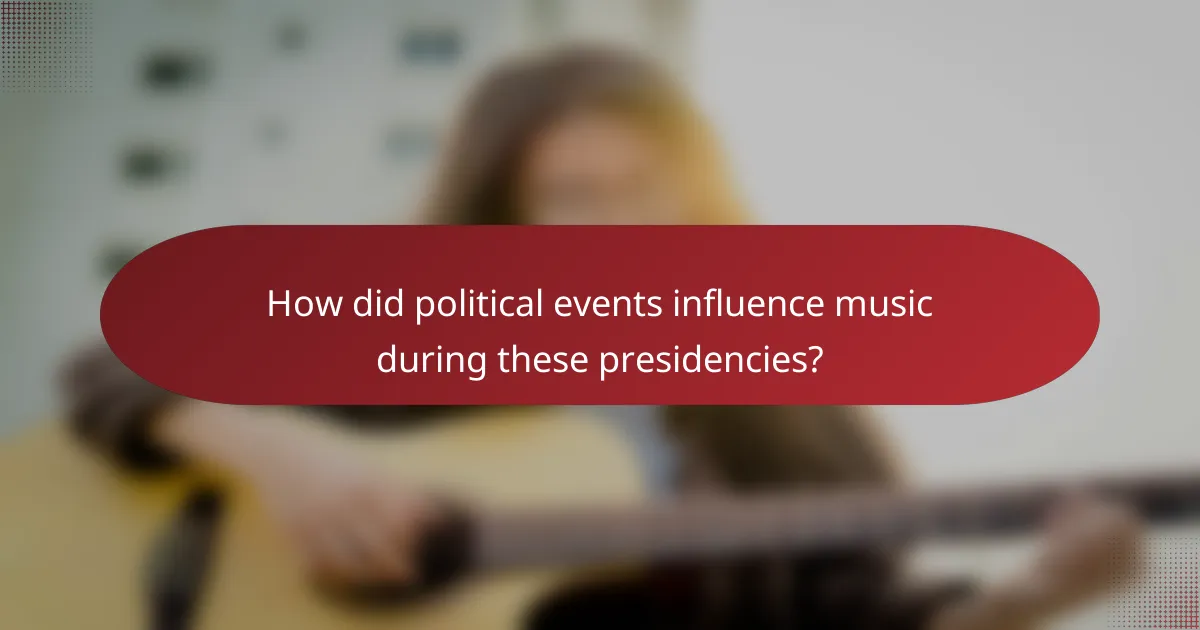
How did political events influence music during these presidencies?
Political events during the presidencies of George W. Bush and Barack Obama significantly shaped the music landscape, reflecting the public’s sentiments and responses to crises. Artists used their platforms to comment on issues such as terrorism, economic downturns, and health care reforms, creating a soundtrack that resonated with the times.
Post-9/11 music landscape
Following the September 11 attacks in 2001, the music scene experienced a shift towards themes of patriotism and mourning. Many artists released songs that addressed the emotional aftermath of the attacks, with genres ranging from rock to hip-hop incorporating messages of resilience and unity.
Notable examples include tracks like “Where Is the Love?” by The Black Eyed Peas and “American Idiot” by Green Day, which critiqued the political climate and the war on terror. This era saw a rise in music festivals and benefit concerts aimed at supporting victims and promoting national solidarity.
Response to economic crises
The financial crisis of 2008 prompted musicians to address themes of economic hardship and social justice. Many songs reflected the struggles of the working class, with artists like Bruce Springsteen and Kanye West voicing frustrations over unemployment and inequality.
Music became a form of protest, with genres like folk and hip-hop leading the charge. Songs such as “The Ghost of Tom Joad” by Springsteen and “Power” by West highlighted the impact of the recession on everyday lives, resonating with audiences facing similar challenges.
Health care reform and music
During Barack Obama’s presidency, the push for health care reform influenced artists to engage with issues surrounding access to medical care. Musicians often used their work to advocate for universal health care and to raise awareness about health disparities.
Tracks like “Fight Song” by Rachel Platten became anthems for empowerment, while other artists participated in campaigns promoting health initiatives. This engagement demonstrated how music could serve as a catalyst for social change, encouraging listeners to advocate for their health rights.

What are the lasting impacts of Bush and Obama on political music?
The political music landscape has significantly evolved due to the presidencies of George W. Bush and Barack Obama. Bush’s era saw a resurgence of protest music, while Obama’s presidency inspired a new wave of artists who blended activism with mainstream appeal.
Legacy of protest songs
The legacy of protest songs during Bush’s presidency is marked by a strong response to the Iraq War and domestic policies. Artists like Green Day and Bruce Springsteen produced music that resonated with widespread discontent, often addressing themes of war, civil rights, and government accountability.
These songs not only served as a form of artistic expression but also mobilized listeners, encouraging political engagement and activism. The emotional weight of these tracks helped to create a cultural dialogue around pressing social issues, making them a vital part of the political music narrative.
Emergence of new artists
Obama’s presidency ushered in a wave of new artists who utilized their platforms to address social justice and equality. Musicians like Chance the Rapper and Janelle Monáe blended genres and messages, appealing to younger audiences while addressing contemporary issues such as racial inequality and climate change.
This era saw a shift towards more diverse voices in political music, with artists leveraging social media to amplify their messages. The accessibility of platforms like YouTube and Spotify allowed these new artists to reach a global audience, fostering a more inclusive political music scene.
